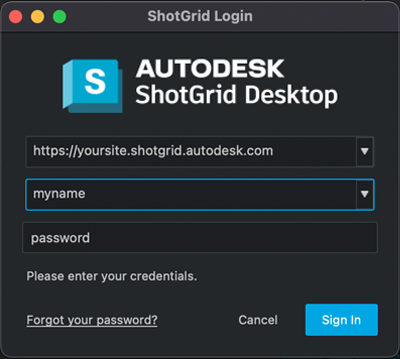如何在自定义脚本中处理身份认证和登录凭据?
错误消息
如果出现类似以下来自脚本的错误,则意味着脚本无权与 ShotGrid 站点进行通信。
tank.errors.TankError: Missing required script user in config '/path/to/your/project/config/core/shotgun.yml'
如果未预先提供用户身份认证或脚本身份认证,则 Toolkit 会回退到检查是否已在配置的 shotgun.yml 文件中定义凭据。
在 shotgun.yml 文件中定义凭据是处理身份认证的旧方法。
您应避免在 shotgun.yml 文件中定义凭据,而改用下面详细介绍的方法之一:
面向用户的脚本
如果脚本面向用户,您可以在创建 Sgtk 实例前,在脚本开头添加以下内容:
# Import the Toolkit API so we can access Toolkit specific features.
import sgtk
# Import the ShotgunAuthenticator from the tank_vendor.shotgun_authentication
# module. This class allows you to authenticate either programmatically or, in this
# case, interactively.
from tank_vendor.shotgun_authentication import ShotgunAuthenticator
# Instantiate the CoreDefaultsManager. This allows the ShotgunAuthenticator to
# retrieve the site, proxy and optional script_user credentials from shotgun.yml
cdm = sgtk.util.CoreDefaultsManager()
# Instantiate the authenticator object, passing in the defaults manager.
authenticator = ShotgunAuthenticator(cdm)
# Optionally clear the current user if you've already logged in before.
authenticator.clear_default_user()
# Get an authenticated user. In this scenario, since we've passed in the
# CoreDefaultsManager, the code will first look to see if there is a script_user inside
# shotgun.yml. If there isn't, the user will be prompted for their username,
# password and optional 2-factor authentication code. If a QApplication is
# available, a UI will pop-up. If not, the credentials will be prompted
# on the command line. The user object returned encapsulates the login
# information.
user = authenticator.get_user()
# print "User is '%s'" % user
# Tells Toolkit which user to use for connecting to ShotGrid. Note that this should
# always take place before creating a Sgtk instance.
sgtk.set_authenticated_user(user)
#
# Add your app code here...
#
# When you are done, you could optionally clear the current user. Doing so
# however, means that the next time the script is run, the user will be prompted
# for their credentials again. You should probably avoid doing this in
# order to provide a user experience that is as frictionless as possible.
authenticator.clear_default_user()
如果 QApplication 可用,您将看到类似如下的内容:

注意
: 如果导入的 Toolkit API(sgtk 软件包)未与配置关联,例如您已下载用于引导到其他配置的 Toolkit API,则不应尝试创建 CoreDefaultsManager。应改为创建 ShotgunAuthenticator() 实例,而不传递默认管理器。
authenticator = ShotgunAuthenticator()
非面向用户的脚本
如果脚本不面向用户,比如在渲染农场或事件处理程序中,您可以在创建 Sgtk/Tank 实例前,在脚本开头添加以下内容:
# Import Toolkit so we can access to Toolkit specific features.
import sgtk
# Import the ShotgunAuthenticator from the tank_vendor.shotgun_authentication
# module. This class allows you to authenticate either interactively or, in this
# case, programmatically.
from tank_vendor.shotgun_authentication import ShotgunAuthenticator
# Instantiate the CoreDefaultsManager. This allows the ShotgunAuthenticator to
# retrieve the site, proxy and optional script_user credentials from shotgun.yml
cdm = sgtk.util.CoreDefaultsManager()
# Instantiate the authenticator object, passing in the defaults manager.
authenticator = ShotgunAuthenticator(cdm)
# Create a user programmatically using the script's key.
user = authenticator.create_script_user(
api_script="Toolkit",
api_key="4e48f....<use the key from your ShotGrid site>"
)
# print "User is '%s'" % user
# Tells Toolkit which user to use for connecting to ShotGrid.
sgtk.set_authenticated_user(user)
注意
: 如面向用户的脚本部分末尾所述,如果您导入的 sgtk 软件包是独立的/不是来自于配置,则不应创建默认管理器。此外,还应为 create_script_user() 方法提供 host kwarg:
user = authenticator.create_script_user(
host="https://yoursite.shotgunstudio.com",
api_script="Toolkit",
api_key="4e48f....<use the key from your Shotgun site>"
)